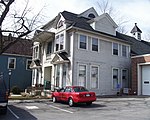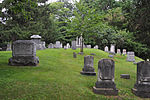David McVean House
Federal architecture in New York (state)Houses in Monroe County, New YorkHouses on the National Register of Historic Places in New York (state)Monroe County, New York Registered Historic Place stubsNational Register of Historic Places in Monroe County, New York

David McVean House, also known as the McVean-Jones-Reeves House, is a historic home located at Scottsville in Monroe County, New York. It is a brick vernacular Federal-style house on a pargeted cut-stone foundation. The five-by-three-bay main block is two stories in height, while the rear wing is one and one-half stories.It was listed on the National Register of Historic Places in 2006.
Excerpt from the Wikipedia article David McVean House (License: CC BY-SA 3.0, Authors, Images).David McVean House
North Road, Town of Wheatland
Geographical coordinates (GPS) Address Nearby Places Show on map
Geographical coordinates (GPS)
| Latitude | Longitude |
|---|---|
| N 43.028055555556 ° | E -77.760555555556 ° |
Address
North Road 813
14546 Town of Wheatland
New York, United States
Open on Google Maps










